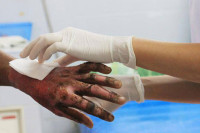Health
Many believe UTI is a toilet-borne infection, doctors say it’s not
Urinary tract infection is one of the most common infections in women, and yet many are not aware of its reasons..jpg&w=900&height=601)
Srizu Bajracharya
Madhurima Bhadra was 14 years old when she experienced her first Urinary Tract Infection. As a young teenager, Bhadra was not sure how she got the infection. She assumed, like many other women, it was a ‘toilet infection’ and the disease-causing bacteria entered her genital tract from her toilet seat. Now 44, and a public health consultant, she laughs at her naivety.
“To put it simply, women can contract UTI when there is a load of bacteria and fungus close to their urethra,” says Bhadra. “It’s not a toilet infection, rather it is a case of personal hygiene. Sometimes it can happen because of obsessive cleaning with unnecessary feminine products,” she says.
According to the Office on Women’s Health, an organisation which is part of the US Department of Health and Human Services, more than half of the world’s women experience UTI at least once in their lives. Many studies also reveal that as many as four in 10 women who get a UTI may be susceptible to the same infection one or more times within six to seven months of their first infection.
UTIs usually affect women’s lower urinary tract, and in severe cases, can also affect the kidney. “It occurs when bacteria [such as E coli] enter the urethra, the duct through which urine passes; it’s a retrograde infection,” says Kenusha Tiwari, a gynaecologist at the Kathmandu Model Hospital. “And the case is more common in women than men because the urethra is shorter in females.”
However, due to the stigma associated with UTI that misconstrues it as a sexually transmitted disease, many people are still not aware of the reasons that might cause UTI, say doctors. “Not many people are comfortable talking about the infection because they are not open to discussing their feminine parts,” says Bhadra.
UTI is a painful and annoying experience for many women. The symptoms include a constant urge to pee, burning urine followed with urine incontinence and pain in the lower abdomen. In some cases, urine may seem cloudy and show blood. People may also get a fever and feel shaky and tired.
Thirty-three-year-old Srijana, who wanted to reveal only her first name, regularly had the bladder infection since first experiencing it when she was 24. “I was rushed to the emergency room once after the pelvic pain got too unbearable. I had this persistent urge to go pee, but I wouldn’t be able to,” she says. At the time Srijana was still recovering from typhoid, and she says the infection happened because her immunity was low.
The doctors prescribed her antibiotics and insisted she drink a lot of water while maintaining personal hygiene. A few months later, Srijana got infected again. This time she got it while she was travelling and believed it was due to lack of proper sanitation while travelling. “When you are on the field for your work you can’t really demand the toilet necessities. All we can do is be aware of the conditions and practice personal hygiene,” she says.
Some reasons why people get the infection include holding in urine for long periods of time, diabetes, obesity or any injury, disability, or disease that makes it difficult to get to the bathroom promptly, such as multiple sclerosis. In many women, UTI also occurs due to hormonal changes and sometimes anything that obstructs urine flow.
Doctors also believe people are more at risk of getting the infection because of their lack of understanding about personal hygiene. “Many women clean their lower parts only from the front. But what should be done is after cleaning with water they need to wipe themselves from front to back. And they should keep themselves dry,” says doctor Tiwari.
Wearing moist undergarments can also cause vaginitis, inflammation of the vagina that can result in discharge, itching and pain, which may develop chances of UTI say doctors.
“Bacteria forms where there is moisture, and that’s why it’s necessary to keep changing your underclothing,” she says. Among the cases Tiwari has treated, the infection seems to be more common in women from remote areas who lack proper knowledge of personal hygiene and toilet sanitation.
Menopause, pregnancy, use of certain types of birth control, and frequent sexual activity may also cause the infection. And it may get transferred to sexual partners. “But the cases of lower tract urinary infection is more common than other types due to people’s lack awareness about personal hygiene,” says Tiwari.
Kalpana Shrestha, 54, has also been suffering from recurrent UTI since her first infection at the age of 30. Shrestha’s infection is a case of chronic UTI which doesn’t respond to medication due to her body’s anatomy. Over the years she has started practising her own home-made remedies which have worked for her. “Drinking neem tea and soaked coriander water has also given me relief when the symptoms have recurred,” says Shrestha.
While there is no specific research that supports her home-made remedy, other studies have found that cranberry juice can also abate UTI and can reduce the risk of it. In an interview with the Health Essentials, the website of Cleaveland Clinic, a US-based health clinic, a urologist Courtenay Moore states, “There is an active ingredient in cranberries that can prevent adherence of bacteria to the bladder wall, particularly E coli.”
However, women can prevent the risks of UTI just by drinking enough water and maintaining a proper diet and personal hygiene, says Tiwari. “But it isn’t a transmissible disease or a toilet infection like many believe,” she says.




 7.12°C Kathmandu
7.12°C Kathmandu














